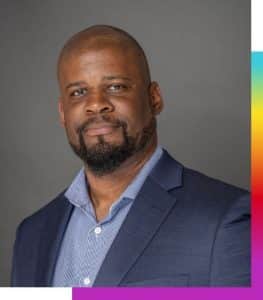
- This event has passed.
Radio Shop Chat: 2024: A Lunar Radio Odyssey (and a few Earth Radio Odysseys) with Dr. Damon Bradley
April 3 @ 1:00 pm - 2:00 pm

Photo of Dr. Damon Bradley provided.
NSF SpectrumX invites you to the April Radio Shop Chat: 2024 A Lunar Radio Odyssey (a few Earth Radio Odysseys), with featured speaker Dr. Damon Bradley, founder and president, DeepSpace Technologies, Inc. This online event will take place on Wednesday, April 3, 2024, at 1 p.m. ET / 10 a.m. PT.
This event is free, and registration is required. Register here.
Abstract:
Damon. C. Bradley, J. O. Burns, N. Gopalswamy, W. M. Farrell, R. MacDowall, J. J. Hibbard, J. Dorigo Jones, D., Rapetti, J. Turner.
The Odysseus lander, built by Intuitive Machines in Houston, Texas, successfully touched down on the Moon on February 22, 2024. This achievement marked a historic milestone as the first commercial spacecraft to land on the lunar surface and the first U.S. spacecraft to do so in over five decades.
The Radio wave Observation at the Lunar Surface of the photoElectron Sheath (ROLSES) instrument, one of six NASA scientific payloads onboard the lander, was developed by the founder and president of DeepSpace Technologies, Dr. Damon Bradley, and DeepSpace chief scientist Dr. William (Bill) Farrell while they were still at NASA in 2021. The instrument is a 4-channel polyphase spectrometer designed to
study the dynamic radio energy environment near the lunar surface between 10kHz and 30 MHz. ROLSES is two spectrometers in one – a low-frequency spectrometer designed to measure a photoelectric radio effect that happens when ionizing solar radiation interacts with the lunar regolith, and a high-frequency spectrometer designed to monitor radio-frequency interference (RFI) from the lander itself, or anthropogenic sources from Earth that may reach the lunar surface. ROLSES is a radio astronomy pathfinding instrument that is the first of its kind to operate on the surface of the Moon.
But Dr. Bradley also has a big focus on passive remote sensing and adjacent band interference sensors in his work. In addition to sharing the story of ROLSES’ design, he will also highlight a new “off-the-shelf” radio signal processing innovation focused on addressing harmful interference in passive remote sensing that he’s currently developing with the assistance of some initial seed funding.
Bio:
Dr. Bradley started DeepSpace Technologies with a passion for and over 20 years of experience at NASA Goddard Space Flight Center, inventing digital signal processing systems for space exploration, astrophysics, and Earth science. While at NASA, he served as a branch head, founder of the Digital Signal Processing Technology group, and an innovator winning approximately $10 million in new funding for various R&D programs in the areas of radio spectrometry, smallsat instrumentation, and planetary
exploration. In addition to scientific research, he managed over 30 projects valued over $100 million with a staff of 74 personnel while branch head in his last 3 years at NASA. Dr. Bradley holds a patent as an inventor of the software-defined-radiometer (patent #10768213) and has developed spectral radio signal processing systems for Earth, Lunar, and Saturn-exploration applications.
Dr. Bradley has developed two radios in space – the Soil Moisture Active Passive (SMAP) L-Band microwave radiometer digital electronics, and the first Lunar radio telescope as a payload onboard the first ever commercial lunar lander developed in the United States – Radio wave Observations at the Lunar Surface of the photoElectron Sheath (ROLSES).
Education
● PhD, Electrical Engineering University of Maryland, Baltimore County, 2014
● M. Eng, University of Maryland, College Park, 2006
● B.S. Electrical Engineering, The Pennsylvania State University, 2002
The SpectrumX Radio Shop Chats are a collegial debate on the pressing issues and optimal model for managing spectrum, as a complex interplay among technology, economics, law, and policy. All Radio Shop Chats are held under the Chatham House Rule.